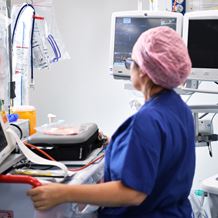What is a pacemaker placement?
A pacemaker insertion is a medical procedure to implant a small electronic device in the chest to help regulate your heartbeat. It consists of a battery and leads, and it is placed in a pocket of skin either side of your chest. In a healthy heart, electrical activity regulates the heartbeat and ensures that enough blood gets pumped around the body. If this system is not working normally, your doctor may recommend a pacemaker insertion. This device helps stabilise an abnormal heart rhythm by sending out electrical signals that help the heartbeat at a normal rate.
What does it do?
A pacemaker insertion is used to treat certain heart conditions such as arrythmia or atrial fibrillation, and it can be programmed to adjust to your specific needs. If it senses that your heart has missed a beat, or is beating dangerously slow, it sends out a series of electrical pulses to correct the rhythm. When your heart is beating normally, the pacemaker is inactive. Pacemakers are usually responsible for ensuring that your heart does not reach a dangerously low heartrate.
How does it work?
When the electrical pathways in the heart are not working as normal, the heart does not beat in a regular rhythm and as a result it cannot function efficiently. A pacemaker insertion is one of the most common types of heart procedures. There are different types of pacemaker available depending on the type of heart condition to be treated. They can last up to 15 years.
- Leadless pacemaker – attached to the inner wall of the heart with no wires
- Single-chamber pacemaker – using one single wire to attach to the heart
- Dual-chamber pacemaker – using two wires to attach to two heart chambers
- Bi-ventricular pacemaker – using three wires to attach to the heart
Why is it performed?
A healthy heart regulates its own heartrate. In some instances, the heart can beat too slowly, and as a result not enough blood gets pumped around the body. This puts additional pressure on the heart. It can happen for a number of reasons that include:
- The natural aging process
- Previous heart damage
- Heart surgery
- Viral heart infections
- Genetic causes
Procedure
A pacemaker insertion is generally considered minor surgery and is performed under a general anaesthetic. It can take up to two hours.
- A small incision is made near the collarbone to create a pocket in the upper chest
- Pacemaker leads are threaded through a vein towards the heart and fixed into position using tiny screws
- The pacemaker is programmed and checked to ensure it is working
- The battery is connected to the leads and tucked inside the pocket of skin
- The wound is stitched and dressed
- When in place, the battery unit can typically be seen as a bulge under the skin.
Recovery
After the procedure, you will be moved on to the ward to rest and recover. There may be some bruising at the insertion site, but this should go away within a few weeks. Your doctor will give you specific instructions on how to manage your pacemaker at home, and what to look out for including any follow-up appointments. Find out more about pacemaker placement recovery.
What's next?
If you have been experiencing heart-related symptoms, book an appointment with our cardiac services specialist today.
Our specialists in Cardiac Services
View all specialists






